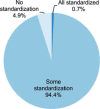Detailed Findings From the CLER National Report of Findings 2018
- PMID: 30154957
- PMCID: PMC6108561
- DOI: 10.4300/1949-8349.10.4s.49
Detailed Findings From the CLER National Report of Findings 2018
Figures


















References
-
- Weiss KB, Bagian JP, Nasca TJ. The clinical learning environment: the foundation of graduate medical education. JAMA. 2013;309(16):1687–1688. - PubMed
MeSH terms
LinkOut - more resources
Full Text Sources
Other Literature Sources
